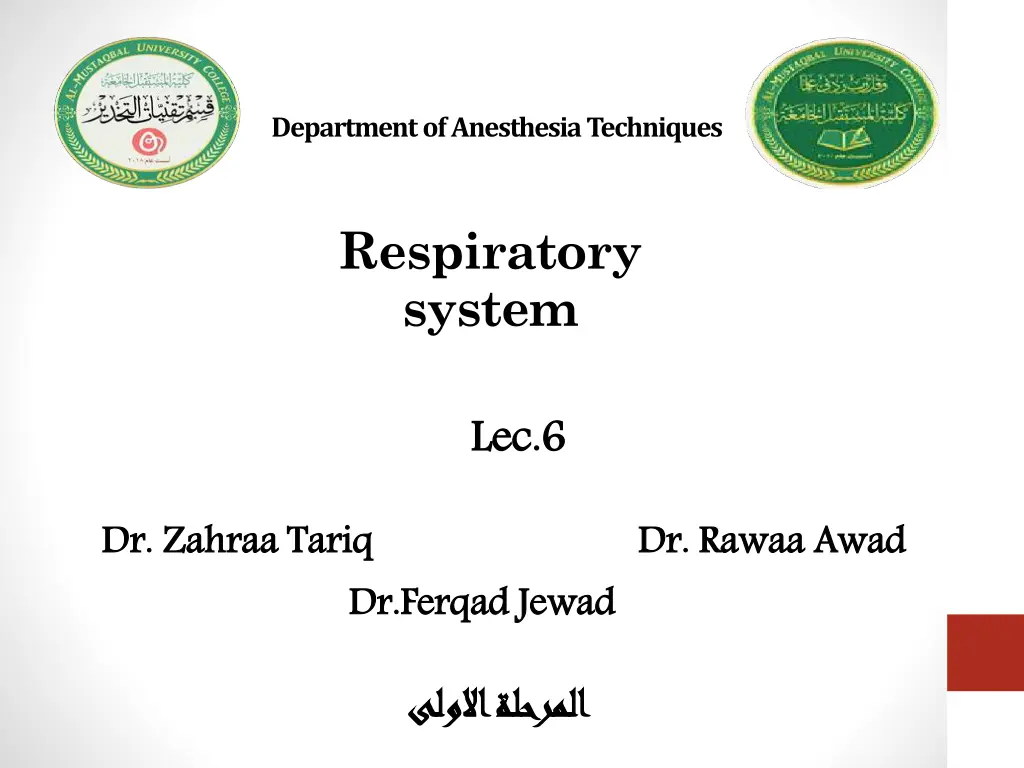
Anesthesia Techniques for Respiratory System: Upper & Lower Airway Overview
Explore the respiratory system's upper airway (nose, pharynx, larynx) and lower airway (trachea, bronchi, lungs). Learn about the functions of each component, from air passage to gas exchange. Discover how the nose warms and filters air, the role of the larynx in swallowing and respiration, and the importance of the lungs in oxygen exchange.
Download Presentation

Please find below an Image/Link to download the presentation.
The content on the website is provided AS IS for your information and personal use only. It may not be sold, licensed, or shared on other websites without obtaining consent from the author. If you encounter any issues during the download, it is possible that the publisher has removed the file from their server.
You are allowed to download the files provided on this website for personal or commercial use, subject to the condition that they are used lawfully. All files are the property of their respective owners.
The content on the website is provided AS IS for your information and personal use only. It may not be sold, licensed, or shared on other websites without obtaining consent from the author.
E N D
Presentation Transcript
DepartmentofAnesthesiaTechniques Respiratory system Lec.6 6 Lec. Dr. Dr. Zahraa Zahraa Tariq Tariq Dr. Rawaa Dr. Rawaa Awad Awad Dr. Dr.Ferqad Ferqad Jewad Jewad
Respiratory system They are classified into: 1. Upper airway: Nose , pharynx and larynx 2. Lower airway: includes the trachea, bronchi and lung. Nose: Function of The Nose: 1.It serves as an air passageway . 2.It warms and moistens inhaled air . 3.It cilia and mucous membrane trap dust , pollen , bacteria and foreign matter 4.It contains olfactory receptors , which smell odors . 5.It aids in phonation and the quality of voice.
Pharynx: Made of muscle and lined with mucous membrane. Function as common opening for digestive and respiratory system.
Larynx ( voice box ) : Composed of cartilage and muscles . Functions :- 1. The protection of the airway during swallowing (When swallowing the backward motion of the tongue forces part of the larynx called the epiglottis to cover up the opening to the larynx). 2. Respiration by maintaining an open passageway for air movement. 3. Phonation: production of voice by vibrating vocal cord.
Trachea (Windpipe) : Is a smooth Muscular tube extends from larynx to bronchi . Function : 1. Passageway for air to and from the lungs. 2. Lined by specialized epithelial tissue, which sweep foreign matter out of the pathway.
Bronchi : Trachea divides into two branches ( bronchi) which enter each lung. Function of bronchi : Providing passageway for air to the lungs .
Lungs There are two lungs,(pyramidal in shape )right and left. Each lung is composed of smaller units called lobes (The right lung consists of three lobes while the left lung consists of two lobes). The two lungs ultimately subdivide into over 300 million alveoli that surrounded by small blood vessels capillaries . Oxygen passes through the thin membranes of the alveoli and into the bloodstream. The red blood cells pick up the oxygen and carry it to the body's organs and tissues. The most basic function of the lungs is to facilitate gas exchange from the bloodstream. environment into the
General Function of Respiratory System. 1. Gas exchange : oxygen enters blood and carbon dioxide leaves. 2. Regulation of blood pH. 3. Voice production : movement of air through vocal folds makes sound and speech. 4. Olfaction : smell occurs when airborne molecules draw into nasal cavity. 5. Protection : by preventing entry of microorganisms and removing them from airway passages.






















